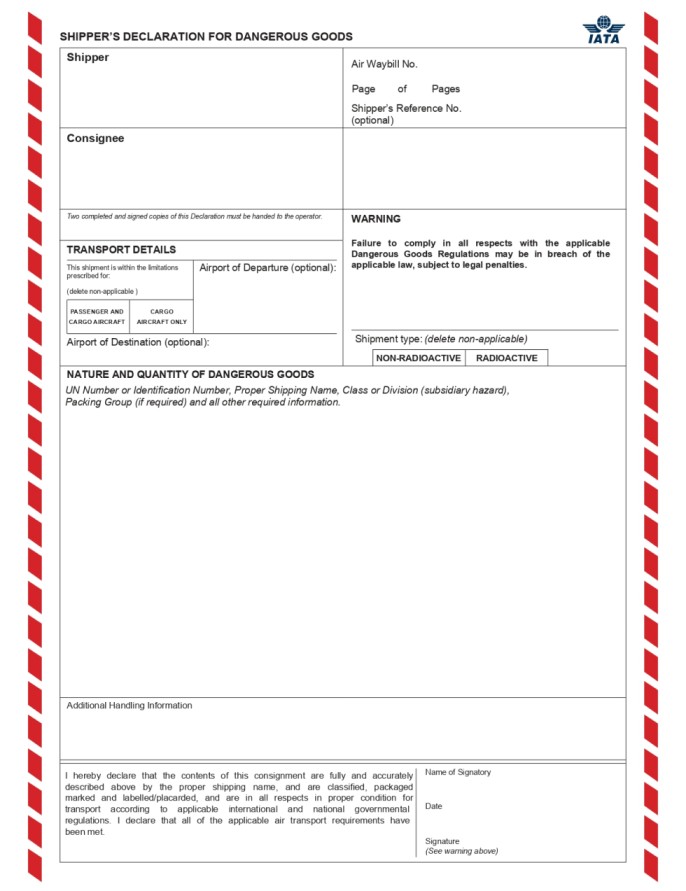What is the Shipper’s Declaration for Dangerous Goods?
The Shipper’s Declaration for Dangerous Goods (DGD) is a legal document that certifies that hazardous materials have been packed, labelled, and declared according to international regulations. The form must be completed by the shipper of the dangerous goods and must contain detailed information about the hazardous materials being shipped.
Below is the general structure of a shipper’s declaration:

How to prepare the Declaration for Dangerous Goods before shipping
To ensure proper handling during transit, it is crucial to complete the shipper’s declaration accurately and attach it to your shipment. Failure to do so may result in delivery delays or fines, and in the worst-case scenario, even an accident.
The following information will be mandatory on the shipper’s declaration form:
1. Shipper/consignor details
Provide the full name, address, and telephone number of the shipper/consignor.
2. Receiver/consignee details
Provide the full name, address, and telephone number of the receiver/consignee.
3. Emergency contact details with country prefix included
If an accident should occur with the shipment, the shipper, receiver, or a responsible representative should be notified immediately.
To ensure prompt communication, an emergency contact number (including the international prefix) must be provided on the shipper’s declaration. Avoid using general local emergency numbers, such as 999 or 112, as the contact person or organisation must be aware of the shipment and its hazards, and must be reachable 24/7.
You can provide the emergency contact details in the Additional Handling Information field if there is no dedicated section on the shipper’s declaration.
4. Air waybill number or tracking number
The air waybill number is entered for air freight shipments, whereas for road freight shipments, the tracking number is entered.
5. Correct UN number
The type of dangerous goods being shipped is identified by a four-digit number found on the product’s SDS (Safety Data Sheet) under section 14, which can be provided by the manufacturer of the goods. Include the UN prefix, such as “UN 1263”, for proper identification when shipping.
6. Proper shipping name
Enter the proper shipping name of the item, which may also include a technical name and other elements.
Example:
Baygon 70% WP Insecticide would be described on the shipper’s declaration as follows:
- Proper Shipping Name: CARBAMATE PESTICIDE, SOLID, TOXIC
- Technical Name: Carbamate Insecticide
- Chemical Name: 2-(1-Methylethoxyl) phenol methylcarbamate
- Trade Name: Baygon 70% WP Insecticide
- UN number: UN 2757
7. Class or division (subsidiary hazard)
Insert the hazard class or division for the substance. For example, Baygon 70% WP Insecticide is classed as 6.1.
8. Net and gross weight of the shipment
The net weight is the weight of the dangerous goods themselves, while the gross weight is the weight of the complete shipment (including product and packaging). To determine whether to fill in the net or gross weight of your shipment, refer to IATA’s Dangerous Goods Regulations.
9. Packing group
Insert the packing group assigned to the dangerous goods, if applicable.
The packing group is a grouping of substances (other than those in Hazard Class 2, Class 6.2, and Class 7), in accordance with the degree of danger they present:
- Packing group I: substances presenting a high danger
- Packing group II: substances presenting a medium danger
- Packing group III: substances presenting a low danger
10. Quantity and type of packaging
Provide a description of the shipment packaging and indicate the quantity of material being shipped (use net quantity unless the regulations require gross mass).
Use metric measurements in your descriptions, as these are more commonly used for shipping in Europe and internationally.
11. Shipment type (radioactive/non-radioactive)
On the shipper’s declaration, strike out the shipment type that does not apply. Since radioactive shipments are subject to more rules and regulations, it is recommended to contact your carrier to confirm the information you need to provide before shipping.
12. Additional handling information (if required)
Include any additional notes relevant to the shipment, such as specific handling instructions.
Need clarification on whether your goods can be sent?
NEED MORE INFORMATION?
FAQ on regulations for shipping dangerous goods & hazardous materials
What are dangerous goods in transport?
Dangerous goods, which are also referred to as hazardous materials or hazmat, can be pure chemicals, mixtures of substances, manufactured products, or articles that can pose a risk to people, animals, or the environment if not handled correctly during use or transport.
Who must sign the Shipper’s Declaration for Dangerous Goods?
The consignor (shipper) must either personally sign the declaration or designate a competent party who possesses a specific qualification or certification in dangerous goods handling or transport to sign on their behalf.
What are the different classes of dangerous goods?
The United Nations (UN) classifies dangerous goods into nine classes, with each hazardous material belonging to at least one of these classes.
- Class 1: Explosives
- Class 2: Gases that are compressed, liquefied, or dissolved under pressure
- Class 3: Flammable liquids
- Class 4.1/4.2/4.3: Flammable solids that may be spontaneously combustible or those which emit flammable gases when in contact with water
- Class 5.1/5.2: Oxidising substances and organic peroxides
- Class 6.1/6.2: Toxic or infectious materials
- Class 7: Radioactive substances
- Class 8: Corrosive substances
- Class 9: Other dangerous and non-classified substances
Can dangerous goods be transported by air?
Dangerous goods can only be transported by air if they comply with regulations set by organisations such as the International Air Transport Association (IATA) and the International Civil Aviation Organization (ICAO).
Do I need to be trained to ship dangerous goods?
Yes, shipping dangerous goods requires adequate training, understanding, and compliance with regulations.
Can I ship dangerous goods with Eurosender?
At Eurosender, we prioritise safety and compliance with regulations. Unfortunately, we cannot ship dangerous goods through our parcel services due to ADR regulations. If dangerous goods are found, the carrier will return them at the expense of the shipper.